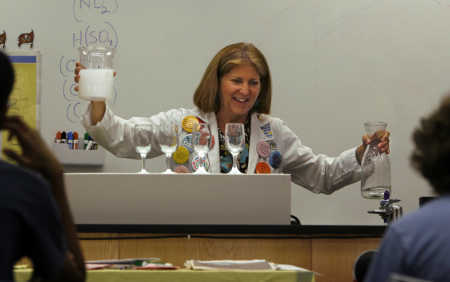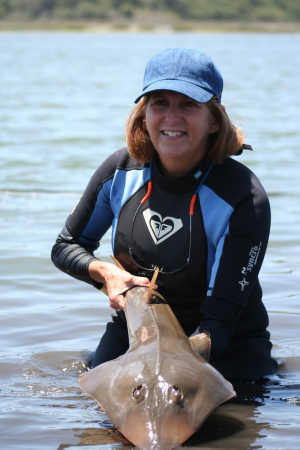 | |||||||||||
|
|
|
|
|
|
|
||||||
|
| |||||||||||
|
September 2,2008 Pinellas teacher ventures from the lab to the sea to the lab - St. Petersburg TimesRita Farlow, Times Staff WriterIn Print: Tuesday, September 2, 2008
PALM HARBOR — It seemed like the trip of a lifetime. Teacher Linda Whitaker was bound for California this summer to spend 10 days working with an accomplished scientist tagging sharks and rays in Monterey Bay. She figured the experience would give her plenty of material on marine wildlife to bring back to her International Baccalaureate students at Palm Harbor University High School. But she came home fired up about another topic: the level of environmental awareness exhibited by Californians. "California is so much more environmentally friendly than we are in Florida. One hundred percent more. It's unbelievable," Whitaker said. "Plastic bags have been completely outlawed in San Francisco." Whitaker, 55, said she was horrified to learn where many of those plastic bags end up: in the Pacific gyre, an area in the north Pacific Ocean where converging currents create a waterborne landfill of epic proportion. Plastic debris there outweighs zooplankton by a factor of 6 to 1, Whitaker said. Partly disintegrated plastic particles, which resemble zooplankton, are ingested by marine mammals, fish and birds, thereby entering the food chain. "The sea is the ultimate garbage can of our entire world," Whitaker said. The lead researcher on Whitaker's summer project is just as emphatic. "It's a big floating mass of plastic," explained Sean Van Sommeran in a telephone interview. The executive director of the Pelagic Shark Research Foundation in Santa Cruz, Calif., Van Sommeran has been studying habitats and migratory patterns of sharks and rays for more than a decade. Whitaker's work with him this summer was sponsored by the Earthwatch Institute, an international conservation organization. One night during the trip, Whitaker and her teammates were watching a Discovery Channel program about sharks. The on-screen expert ? Van Sommeran. Scientists long have wondered about sharks' migratory patterns. Van Sommeran and other researchers have been tagging them to see how far they travel. "He tagged a blue shark (in California) in 2000,'' Whitaker said. "In 2002, off the coast of Japan … they captured that same tagged blue shark. They do migrate." Van Sommeran co-sponsored an initiative to protect white sharks in Monterey Bay and pushed for limitations on recreational shark fishing that became law in California. He also was part of the team that found the first giant squid in Monterey Bay. Cool stuff. The kind that makes for engaging science classes. Whitaker returned to Florida in August, armed with data on thornyback rays and leopard sharks to share with her students. But the lesson plan she's most excited about stemmed from her experiences during a beach cleanup and recycling effort and her newfound awareness of the Pacific gyre. "I've just been more educated (about the environment)," Whitaker said. "That's what I'm hoping to bring home to my kids." Whitaker wants to encourage students to start a schoolwide plastic recycling program. Or better yet, inspire them to quit using plastic bottles and grocery bags altogether. Who knows? Maybe her students will help propel a movement toward alternative plastics made from corn or soybeans. And that's exactly the point, said Kevin McAndrew, Earthwatch outreach coordinator. "The purpose is to engage them in a way that opens their eyes to the fact that they are part of something much larger," he said. Rita Farlow can be reached at farlow@sptimes.com or (727) 445-4162. >>fast facts Learn more about Earthwatch's work Linda Whitaker's 10-day trip to collect data on sharks and rays in Monterey Bay was funded through a $3,000 grant from the Tampa Bay Rays Earthwatch Fellowship program. Earthwatch Institute, an international nonprofit research, conservation and education organization, was founded in 1971. Field scientists are paired with educators, who provide volunteer labor on a variety of environmental research projects around the world. Teachers then pass along to their students what they've learned. For information, visit www.earthwatch.org. Want to see more photos from Whitaker's trip? Go to her school Web page at web.me.com/chemmax/chemmax/welcome.html and click on "Earthwatch blog." View a video about how nonbiodegradable plastic bottles affect marine environments in a video Whitaker will include in a lesson plan inspired by her trip: www.algalita.org/pelagic_plastic_mov.html. Original URL (may no longer function): http://www.tampabay.com/news/education/teachers/article792604.ece
Copyright © St. Petersburg Times. All rights reserved.
|
 [JIM DAMASKE | Times] Science teacher Linda Whitaker leads a chemistry lab for International Baccalaureate students at Palm Harbor University High School.  [Courtesy of Linda Whitaker] Whitaker holds a thornyback ray during her 10-day trip to help tag sharks and rays off the coast of California. |
| |
[ home ] | [ contact us ] | [ support us ] | [ shop ] | © Copyright 1990-2010 PSRF All rights reserved. |
Site Development by IT Director |